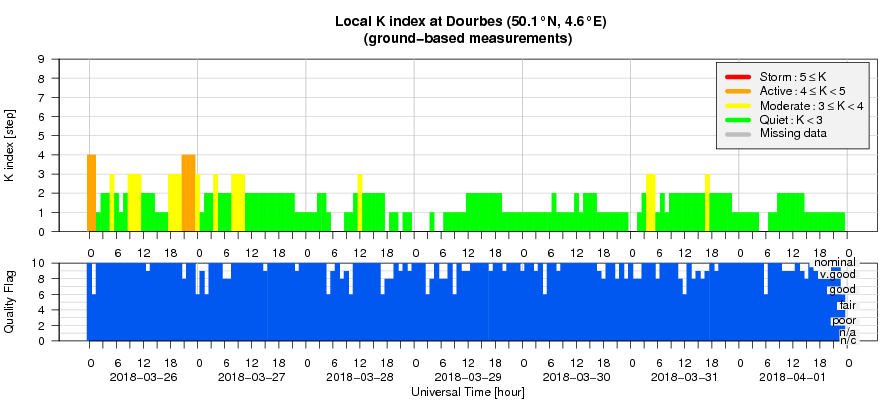- Table of Content
- 1.Soyuz spotted
- 2.ESWW2018 - Cal...
- 3.PROBA2 Observa...
- 4.Review of sola...
- 5.The Internatio...
- 6.Review of geom...
- 7.Geomagnetic Ob...
- 8.Review of iono...
2. ESWW2018 - Call for Topical Discussion Meetings
3. PROBA2 Observations (26 Mar 2018 - 1 Apr 2018)
4. Review of solar activity
5. The International Sunspot Number
6. Review of geomagnetic activity
7. Geomagnetic Observations at Dourbes (26 Mar 2018 - 1 Apr 2018)
8. Review of ionospheric activity (26 Mar 2018 - 1 Apr 2018)
Soyuz spotted
The radio meteor network FRIPON saw a peculiar 'meteor' on March 25:
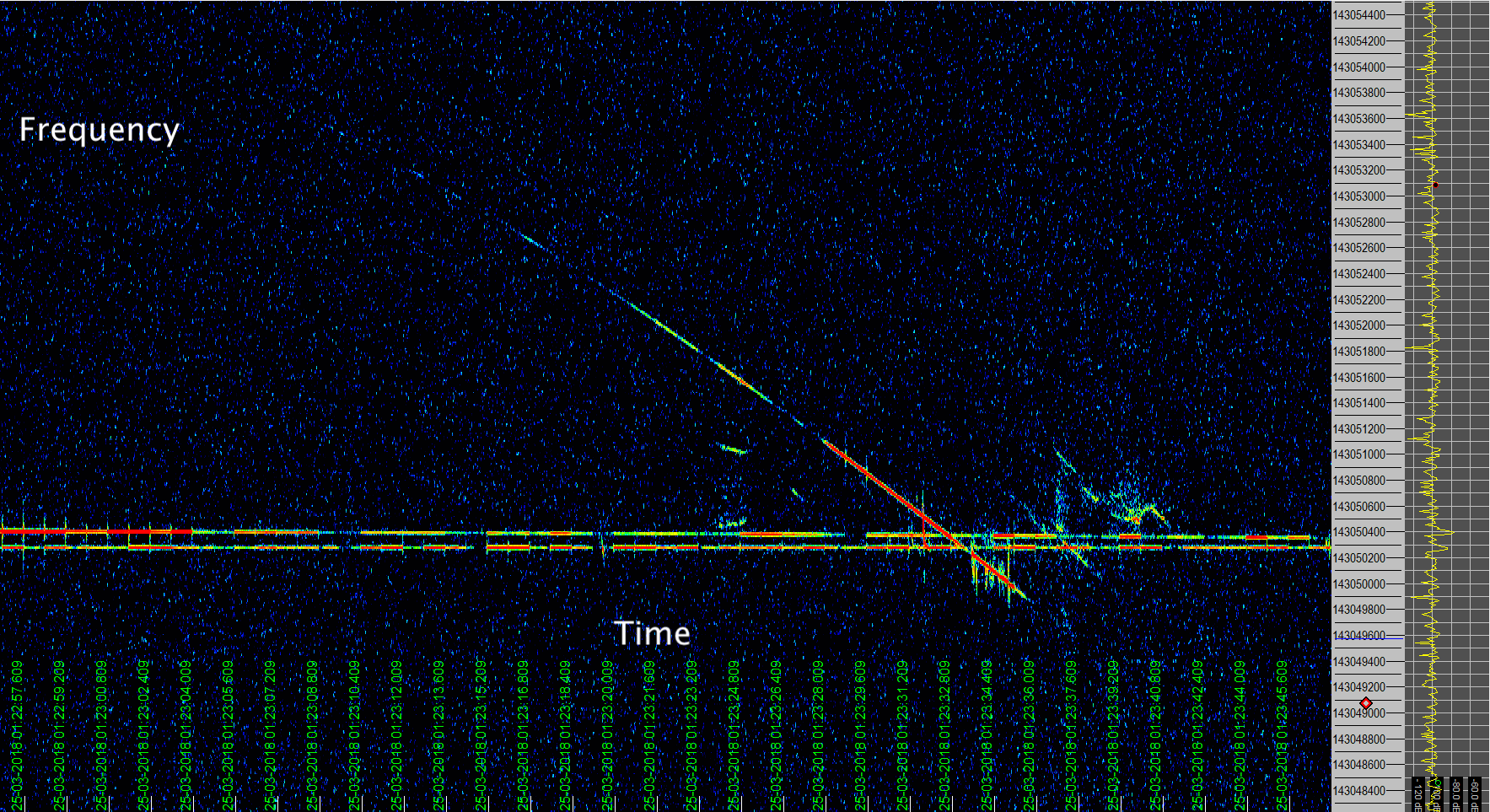
The diagonal line is something that moves through the sky. Where it flying Easter eggs on their way to arrive on April 1? A meteors squadron?
No, it was a Soyuz rocket stage that burns up over the Mediterranean! Emitted radio waves bounce back on objects like meteors in the sky leaving a trace in the data. This time it was not a meteor echo but a rocket echo. Amazing isn't it!
Thanks to Jean-Louis Rault for this nice story.
About the figure: Spectogram with time on horizontal axis, frequency on the vertical axis. The colour indicate the intensity of the echo.
FRIPON: https://www.fripon.org/?lang=en
BRAMS (Belgian RAdio Meteor Stations network): http://brams.aeronomie.be
News item on meteor detection by BRAMS: http://www.stce.be/node/313
ESWW2018 - Call for Topical Discussion Meetings

Dear Colleagues
The European Space Weather Week is an excellent place to discuss all sorts of space weather issues and to look for partners and collaborators. The ESWW Programme Committee (PC) wants to stimulate and facilitate this by offering rooms and time slots for what is called ‘Topical Discussion Meetings’ (TDM).
A TDM is a 1h 15min meeting and aims at discussion and interaction between the participants.TDMs are announced through the ESWW-website and the printed program book and are open to all ESWW participants. Technical support will be provided during the meetings. TDMs take place in the afternoon from Monday to Thursday.
More info about TDMs: http://www.stce.be/esww15/tdm.php
We would like to invite and encourage you and your colleagues to submit a title and short abstract for a Topical Discussion Meeting. The deadline for submission is 18 May, 2018 included. Use the above link for submission.
The PC decides which of the submissions are accepted and arranges the time schedule with the least possible clashes. Conveners will be notified as early as possible and no later than the end of June (after the PC meeting).
With kind regards
Mauro Messerotti and Petra Vanlommel, on behalf of the ESWW PC
PROBA2 Observations (26 Mar 2018 - 1 Apr 2018)
Solar Activity
Solar flare activity fluctuated between very low and low during the week.
In order to view the activity of this week in more detail, we suggest to go to the following website from which all the daily (normal and difference) movies can be accessed: http://proba2.oma.be/ssa
This page also lists the recorded flaring events.
A weekly overview movie can be found here (SWAP week 418): http://proba2.oma.be/swap/data/mpg/movies/weekly_movies/weekly_movie_2018_03_26.mp4
Details about some of this week's events, can be found further below.
If any of the linked movies are unavailable they can be found in the P2SC movie repository here: http://proba2.oma.be/swap/data/mpg/movies/
Friday Mar 30
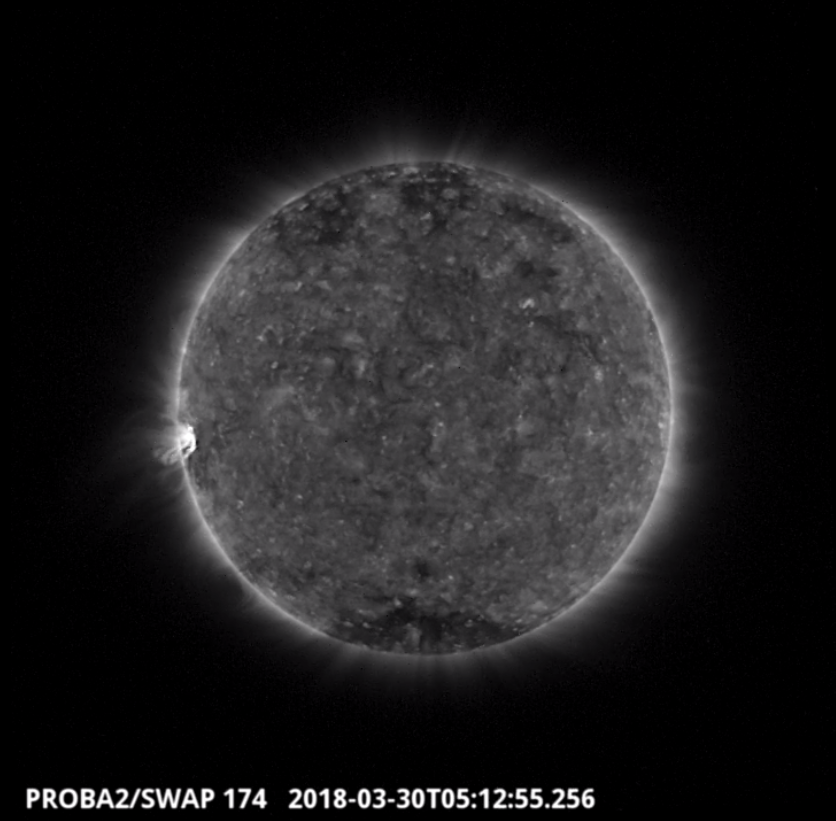
An eruption was observed by SWAP on the east limb of of the Sun on 2018-Mar-30, shown in the SWAP image above at 05:12 UT.
Find a movie of the event here (SWAP movie): http://proba2.oma.be/swap/movies/20180330_swap_movie.mp4
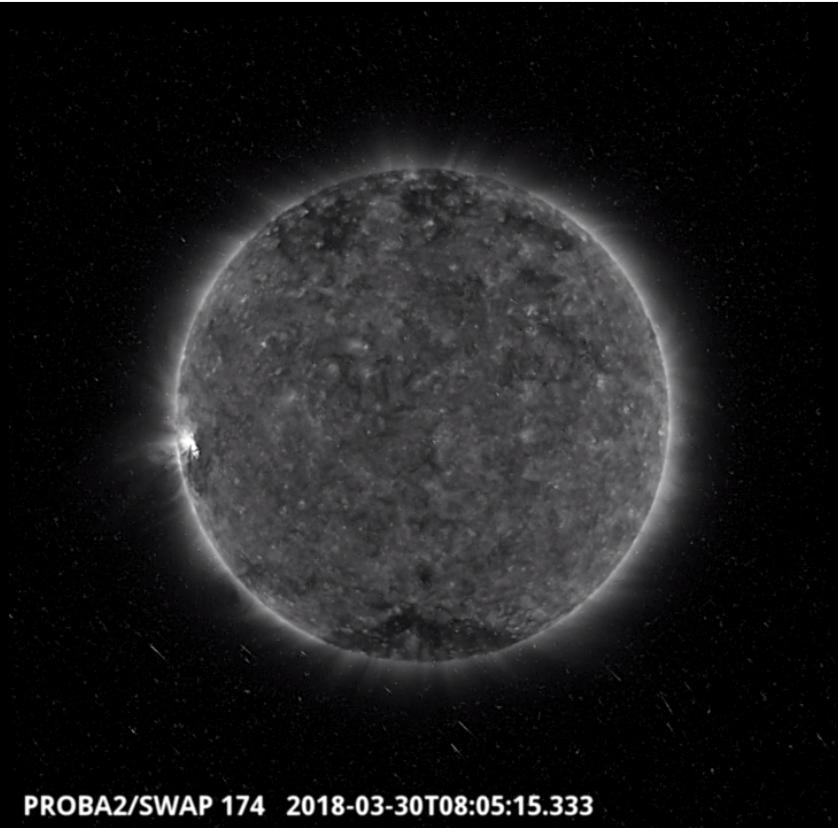
Also on 2018-Mar-30, SWAP observed the largest flare of the week (C4.6), which was associated with NOAA 2703. This is visible on the east limb of the Sun in the SWAP image above at 08:05 UT.
Find a movie of the event here (SWAP movie): http://proba2.oma.be/swap/movies/20180330_swap_movie.mp4
Sunday Apr 01
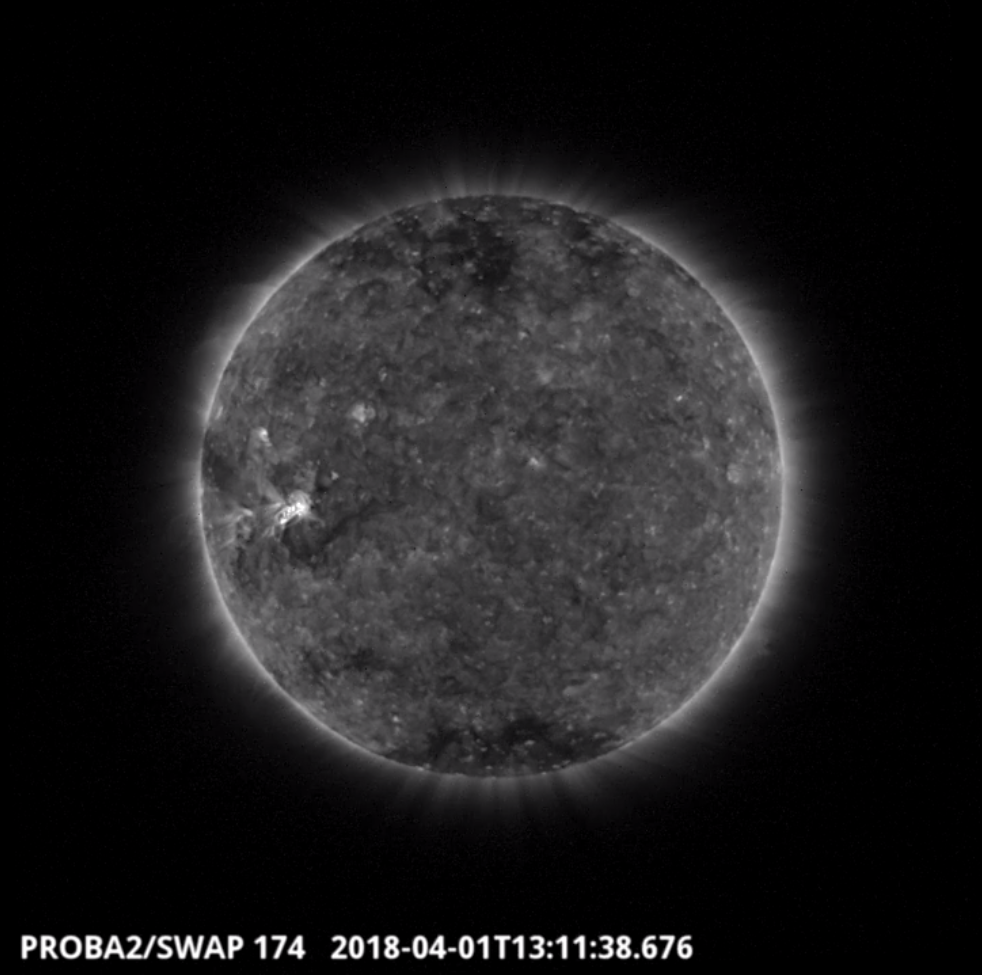
The second largest flare of the week (B9.0), associated with NOAA 2703, was observed by SWAP on 2018-Apr-01. This is visible in the SWAP image above towards the east of the solar disk at 13:11 UT.
Find a movie of the event here (SWAP movie): http://proba2.oma.be/swap/movies/20180401_swap_movie.mp4
Review of solar activity
The GOES X-ray background was around A1 level throughout the week.
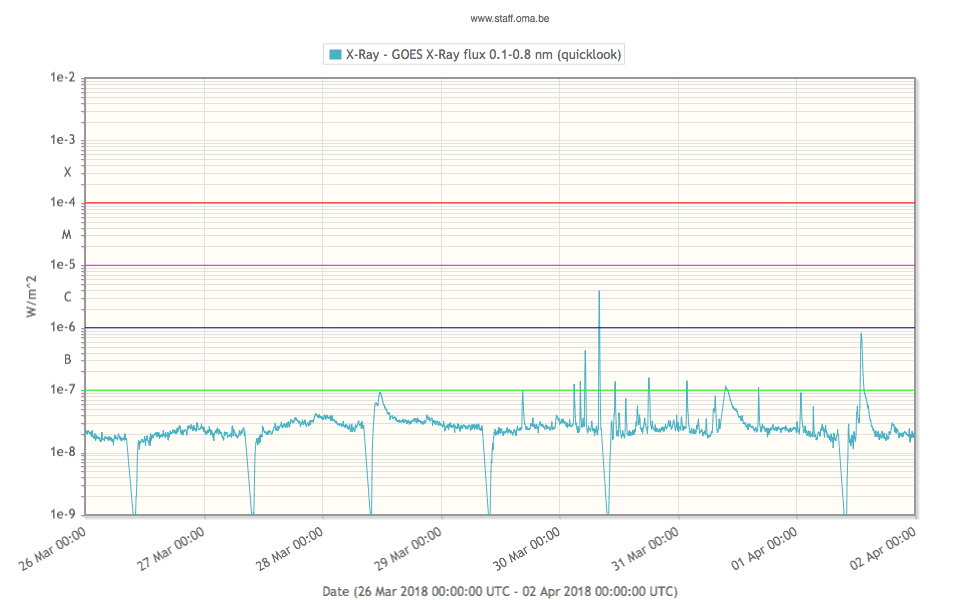
There were no sunspots on the near side of the Sun until March 30, when alpha region NOAA AR 2703 rotated around the East limb. This region produced several B flares as well as one C flare.
Below, three sunspot drawings from the Royal Observatory of Belgium (http://sidc.oma.be/uset/). The sunspots, black features present on the projected solar image are pen-traced . On March 30, 1 group with 1 sunspot appears at the East limb of the Sun. It remains visible until March 31. On April 1, it disappears.
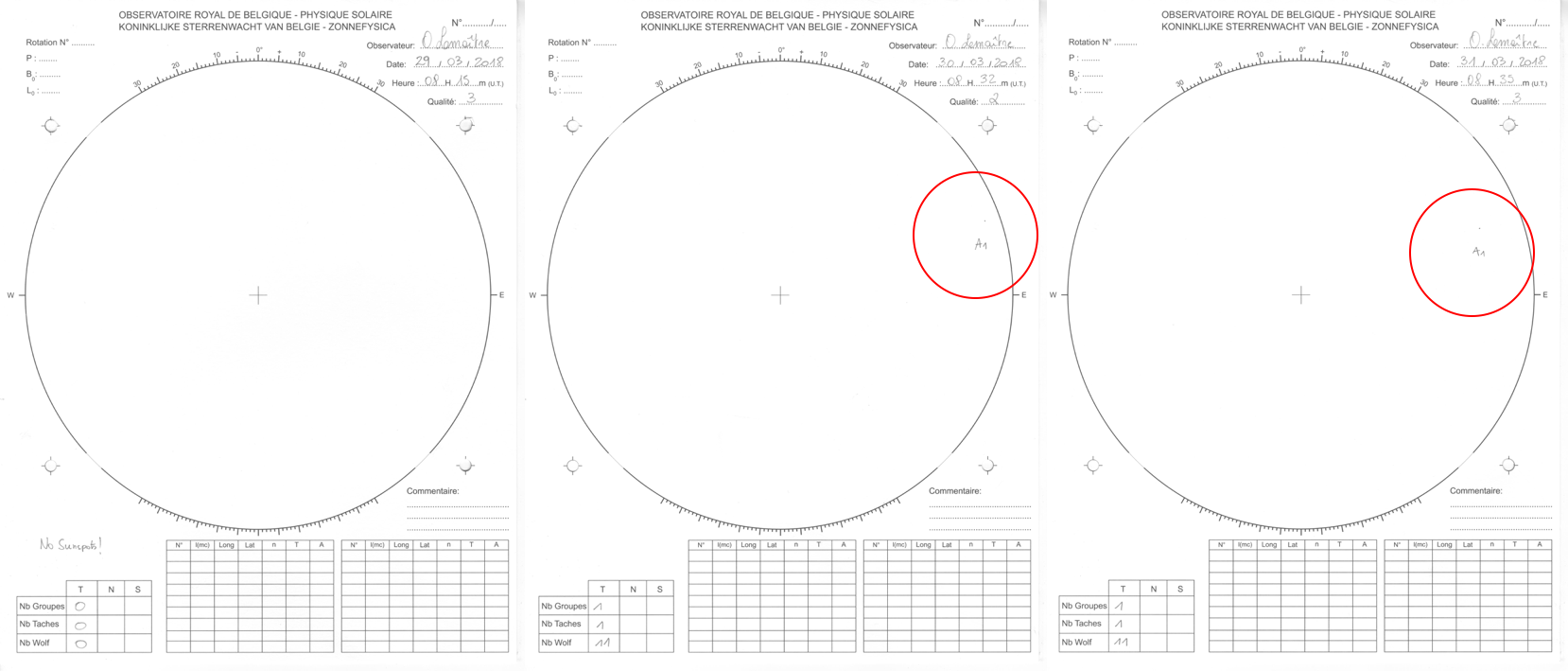
There were no filament eruptions nor Earth-directed CMEs.
The greater than 10 MeV proton flux was at nominal levels throughout the week.
The International Sunspot Number
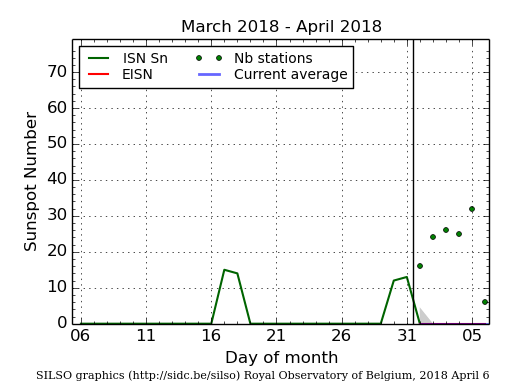
The daily Estimated International Sunspot Number (EISN, red curve with shaded error) derived by a simplified method from real-time data from the worldwide SILSO network. It extends the official Sunspot Number from the full processing of the preceding month (green line). The plot shows the last 30 days (about one solar rotation). The horizontal blue line shows the current monthly average, while the green dots give the number of stations included in the calculation of the EISN for each day.
The numbers are going down. A similar tendency can be seen in the F10.7 cm flux.
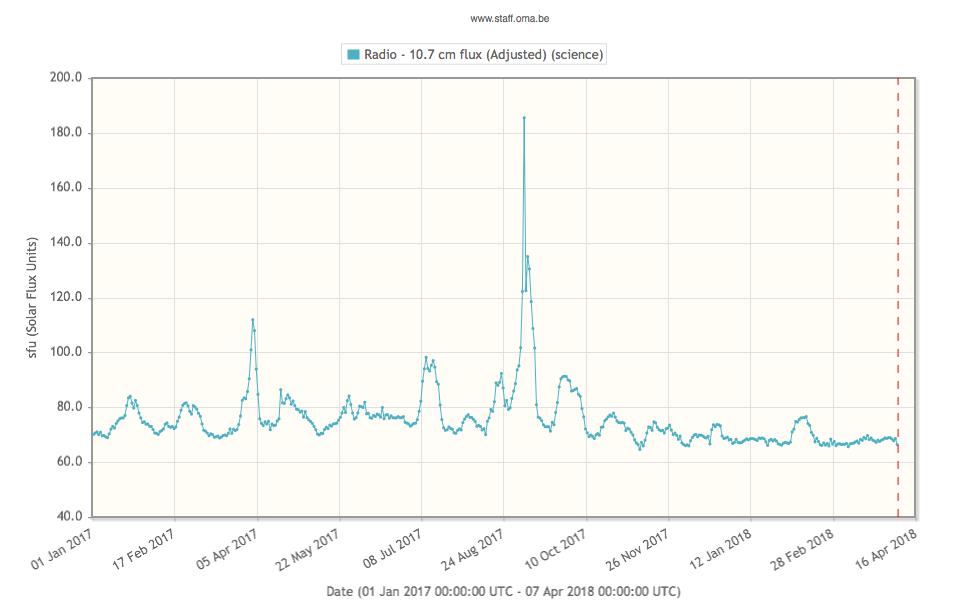
An now the sunspot number together with the F10.7 cm flux. The sunspot number ranges from 0 to 140. The F10.7 cm flux between 60 and 200.
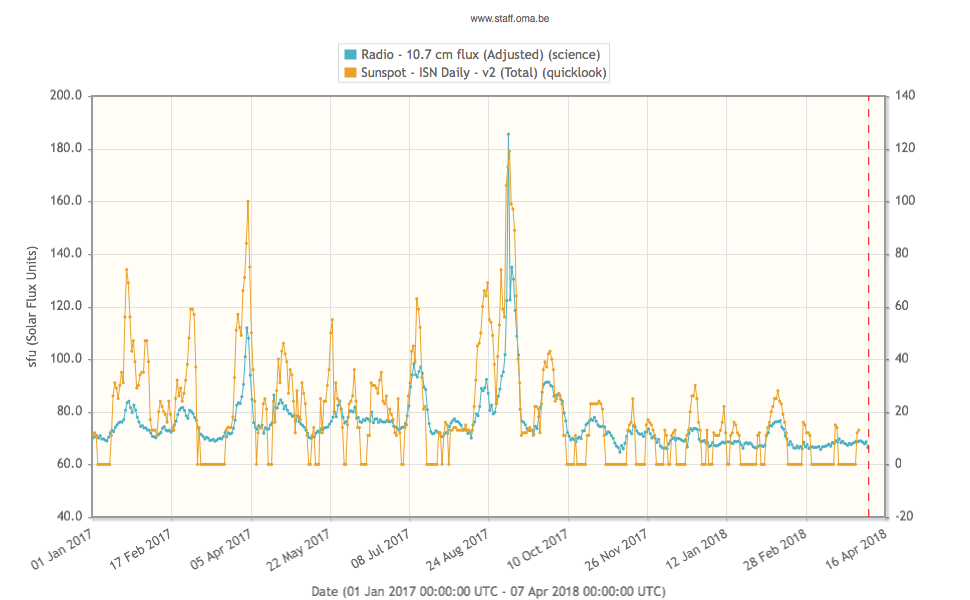
Review of geomagnetic activity
On March 26 and 27, the solar wind near Earth was enhanced due to the influence of a negative polarity coronal hole (CH) wind stream, with solar wind speeds measured by DSCOVR up to about 560 km/s. The Interplanetary Magnetic Field (IMF) was directed towards the Sun and its magnitude reached about 8 nT.
This resulted in KDourbes 4 on March 26.
On March 28, the solar wind speed started decreasing until it reached a minimum of about 340 km/s on March 29.
The solar wind near Earth showed the first signs of influence from a positive polarity, northern polar CH wind stream around 6 UT on March 29, with increasing density and disturbed IMF. Solar wind speed suddenly increased from about 380 to 450 km/s around 17:26 UT on March 29. This coincided with a sector boundary crossing, with the IMF changing from a negative (towards the Sun) to a positive sector (away from the Sun).
Throughout the rest of the week, the solar wind speed varied between about 380 and 485 km/s, while the magnitude of the IMF ranged between about 1 and 10 nT. There were no prolonged intervals with Bz below -5 nT.
The impact on the geomagnetic field was limited. KDourbes was maximal 3.
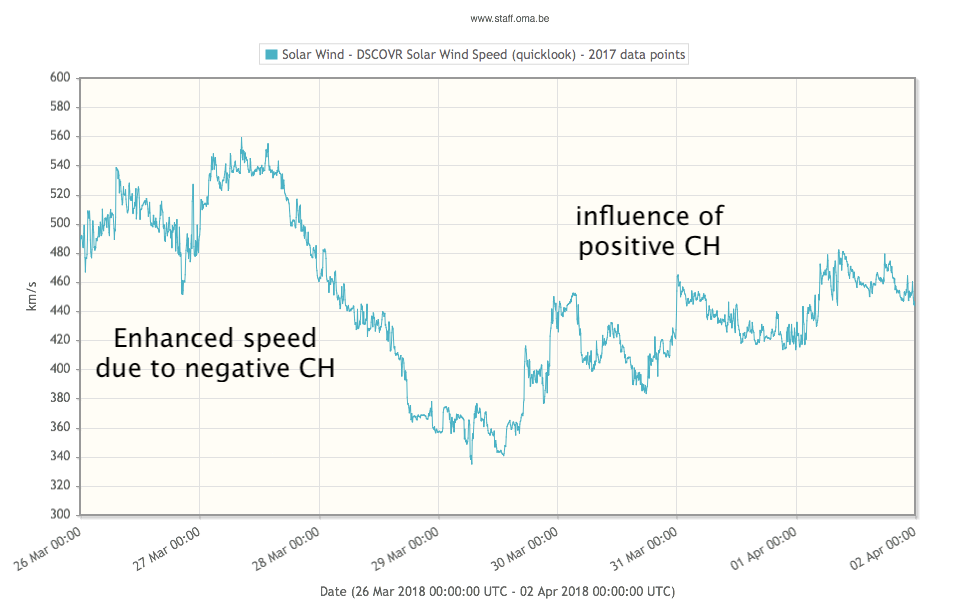
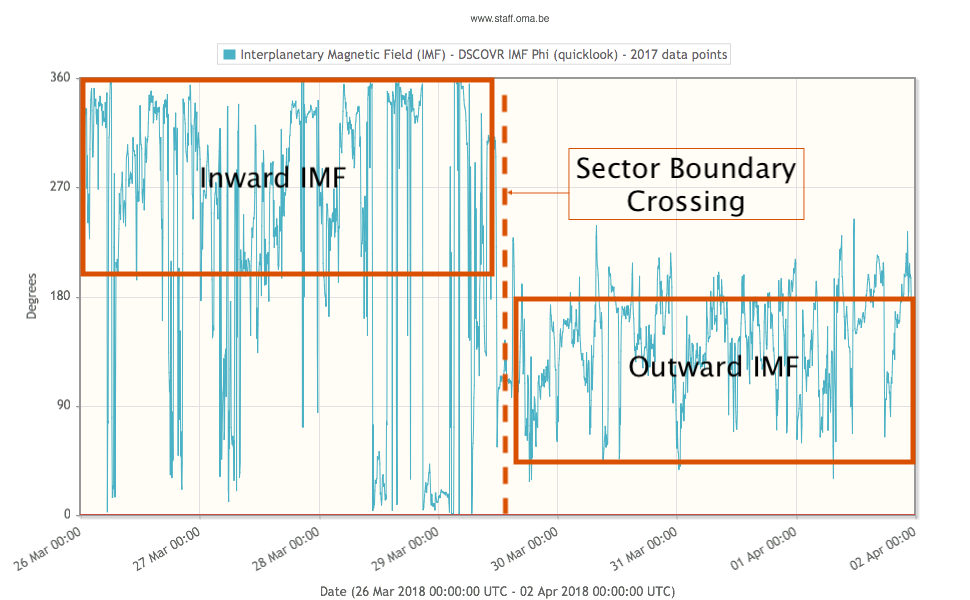
Review of ionospheric activity (26 Mar 2018 - 1 Apr 2018)
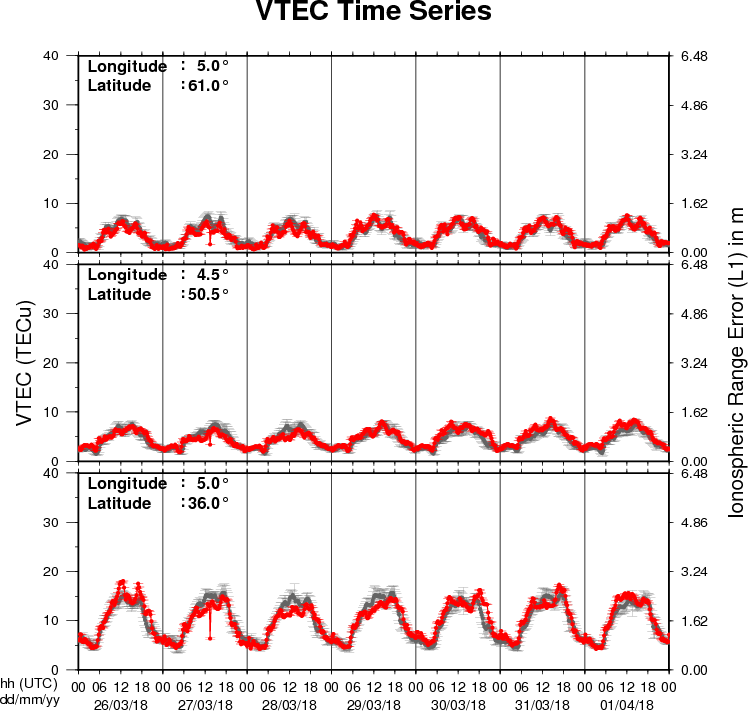
The figure shows the time evolution of the Vertical Total Electron Content (VTEC) (in red) during the last week at three locations:
a) in the northern part of Europe(N61°, 5°E)
b) above Brussels(N50.5°, 4.5°E)
c) in the southern part of Europe(N36°, 5°E)
This figure also shows (in grey) the normal ionospheric behaviour expected based on the median VTEC from the 15 previous days.
The VTEC is expressed in TECu (with TECu=10^16 electrons per square meter) and is directly related to the signal propagation delay due to the ionosphere (in figure: delay on GPS L1 frequency).
The Sun's radiation ionizes the Earth's upper atmosphere, the ionosphere, located from about 60km to 1000km above the Earth's surface.The ionization process in the ionosphere produces ions and free electrons. These electrons perturb the propagation of the GNSS (Global Navigation Satellite System) signals by inducing a so-called ionospheric delay.
See http://stce.be/newsletter/GNSS_final.pdf for some more explanations ; for detailed information, see http://gnss.be/ionosphere_tutorial.php
